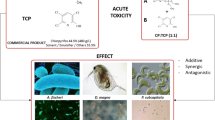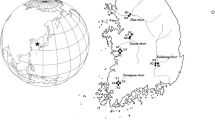Abstract
The sensitivity of Heterocypris incongruens to selected heavy metal ions is discussed. Although the Ostracodtoxkit\({\textregistered}\) has been present on the market for a few years, data on its selectivity and sensitivity to toxicants is scarce; such data is indispensable when interpreting the results of sediment toxicity. The LC50 and EC50 results with the Ostracodtoxkit\({\textregistered}\) are compared with those obtained with other commercially available “direct-contact” tests (utilizing Hyalella azteca and Chironomus riparius) and microbiotests for assessing the toxicity of aqueous samples (Vibrio fischeri, Daphnia magna, and Selenastrum capricornatum). The sensitivity of H. incongruens to metal ions (Cd2 + > >Hg2 + > Cu2 + >Cr6 + >Ni2 + ≈Mn7 + >Zn2 + >Pb2 + >Li1 + > Fe3 + ) was found to be similar to that of H. azteca and of C. riparius. The Ostracodtoxkit\({\textregistered}\) has shown itself to be an efficient and reliable element of test batteries for toxicity determination.
Similar content being viewed by others
References
Arambasic, M. B., Bjelic, S., & Subakov, G. (1995). Acute toxicity of heavy metals (copper, lead, zinc), phenol and sodium on Allium cepa, Lepidium sativum and Daphnia magna: Comparative investigations and the practical applications. Water Research, 29, 497–503.
Bechard, K. M., Gillis, P. L., & Wood, C. M. (2008). Acute toxicity of waterborne Cd, Cu, Pb, Ni, and Zn to first-instar Chironomus riparius larvae. Archives of Environmental Contamination and Toxicology, 54(3), 454–459.
Biesinger, K. E., & Christensen, G. M. (1972). Effects of various metals on survival, growth, reproduction and metabolism of Daphnia magna. Journal of the Fisheries Research Board of Canada, 29(12), 1691–1700.
Blaise, C., Gagne, F., & Bombardier, M. (2000). Recent developments in microbiotesting and early millennium prospects. Water, Air, and Soil Pollution, 123, 11–23.
Borgmann, U., Couillard, Y., Doyle, P., & Dixon, D. G. (2005). Toxicity of sixty-three metals and metalloids to Hyalella azteca at two levels of water hardness. Environmental Toxicology and Chemistry, 24, 641–652.
Bowmer, C. T., Hooftman, R. N., Hanstveit, A. O., Vendersbosch, P. W. M., & van der Hoeven, N. (1998). The ecotoxicity and the biodegradability of lactic acid, alkyl lactate esters and lactate salts. Chemosphere, 37(7), 1317–1333.
Call, D. J., Brooke, L. T., Lindberg, C. A., Markee, T. P., McCauley, D. J., & Poirier, S. H. (1984). Toxicity of aluminum to freshwater organisms in water of pH 6,5-8,5, Tech. Rep. Project No. 549-238-RT-WRD, Center for Lake Superior Environmental Studies, University of Wisconsin, Superior, Wl./November 27, 1984 Memo to C. Stephan, U.S. EPA, Duluth, Mn:46
Casado-Martinez, M. C., Fernandez, N., Troja, J. M., & DelValls, T. A. (2007). Liquid versus solid phase bioassays for dredged material toxicity assessment. Environment International, 33, 456–462.
Chen, C. Y. (1994). Theoretical evaluation of the inhibitory effects of mercury on algal growth at various orthophosphate levels. Water Research, 28(4), 931–937.
Chen, C. Y., Lin, K. C., & Yang, D. T. (1997). Comparison of the relative toxicity relationships based on batch and continuous algal toxicity tests. Chemosphere, 35(9), 1959–1965.
Christensen, E. R., Scherfig, J., & Dixon, P. S. (1979). Effects of manganese, copper and lead on Selenastrum capricornatum and Chlorella stigmatophora. Water Research, 13(1), 79–92.
Clement, B., & Cadier, C. (1998). Development of a new laboratory freshwater/sediment microcosm test. Ecotoxicology, 7, 279–290.
de Boer, W. J., den Besten, P. J., & Ter Braak, C. F. (2002). Statistical analysis of sediment toxicity by additive monotone regression splines. Ecotoxicology, 11, 435–450.
Guéguen, C., Gilbin, R., Pardos, M., & Dominik, J. (2004). Water toxicity and metal contamination assessment of a polluted river: The Upper Vistula River (Poland). Applied Geochemistry, 19, 153–162.
Hsieha, C.-Y., Tsaib, M.-H., Ryanc, D. K., & Pancorbo, O. C. (2004). Toxicity of the 13 priority pollutant metals to Vibrio fischeri in the Microtox® chronic toxicity test. The Science of the Total Environment, 320, 37–50.
Hooftman, R. N., Adema, D. M. M., & Kauffman-Van Bommel, J. (1989). Developing a set of test methods for the toxicological analysis of the pollution degree of water bottoms, Rep. No.16105, Netherlands Organization for Applied Scientific Research, 68 (DUT).
Ibrahim, H., Kheir, R., Helmi, S., Lewis, J., & Crane, M. (1998). Effects of organophosphorus, carbamate, pyrethroid and organochlorine pesticides, and a heavy metal on survival and cholinesterase activity of Chironomus riparius Meigen. Bulletin of Environmental Contamination and Toxicology, 60, 448–455.
Kimball, G. (1978). The effects of lesser metals and one organic to fathead minnow (Pimephales promelas) and Daphnia magna, Manuscript, Dept. of Entomology, Fisheries and Wildlife, University of Minnesota, Minneapolis, MN, p. 88.
Lilius, H., Hastbacka, T., & Isoma, B. (1995). A comparison of the toxicity of 30 reference chemicals to Daphnia magna and Daphnia pulex. Environmental Toxicology and Chemistry, 14, 2085–2088.
Milani, D., Reynoldson, T. B., Borgmann, U., & Kolasa, J. (2003). The relative sensitivity of four benthic invertebrates to metals in spiked-sediment exposures and application to contaminated field sediment. Environmental Toxicology and Chemistry, 22(4), 845–854.
Mount, D. R., Gulley, D. D., Hockett, J. R., Garrison, T. D., & Evans, J. M. (1997). Statistical models to predict the toxicity of major ions to Ceriodaphnia dubia, Daphnia magna and Pimephales promelas (Fathead minnows). Environmental Toxicology and Chemistry, 16(10), 2009–2019.
Muyssen, B. T. A., Janssen, C. R., & Bossuyt, B. T. A. (2002). Tolerance and acclimation to zinc of field-collected Daphnia magna populations. Aquatic Toxicology, 56, 69–79.
Pascoe, D., Wenzel, A., Janssen, C., Girling, A. E., Juèttner, I., Fliedner, A., et al. (2000). The development of toxicity tests for freshwater pollutants and their validation in stream and pond mesocosms. Water Research, 34(8), 2323–2329.
Radetski, C. M., Ferard, J.-F., & Blaise, Ch. (1995). A semistatic microplate-based phytotoxicity test. Environmental Toxicology and Chemistry, 14, 299–302.
Rossaro, B., Gaggino, G. F., & Marchetti, R. (1986). Accumulation of mercury in larvae and adults, Chironomus riparius (Meigen). Bulletin of Environmental Contamination and Toxicology, 37(3), 402–406.
Sauser, K. R., Liu, J. K., & Wong, T. Y. (1997). Identification of copper-sensitive ascorbate peroxidase in the unicellular green algae Selenastrum capricornatum. Biometals, 10(3), 163–168.
Schweiger, G. (1957). The toxic action of heavy metals salts on fish and organisms on which fish feed. Archiv Fischereiwiss, 8, 54–78.
Seco, J. I., Fernandez-Pereira, C., & Vale, J. (2003). A study of the leachate toxicity of metal-containing solid wastes using Daphnia magna. Ecotoxicology and Environmental Safety, 56, 339–350.
Stephenson, R. R. (1983). Effects of water hardness, water temperature and size of the test organism on the susceptibility of the freshwater shrimp, Gammarus pulex (L.) to toxicants. Bulletin of Environmental Contamination and Toxicology, 31(4), 459–466.
Timmermans, K. R., Peeters, W., & Tonkes, M. (1992). Cadmium, zinc, lead and copper in Chironomus riparius (Meigen) larvae (Diptera, Chironomidae): Uptake and effects. Hydrobiologia, 241(2), 119–134.
Versteeg, D. J., Stalmans, M., Dyer, S. D., & Janssen, C. (1997). Ceriodaphnia and Daphnia: A comparison of their sensitivity to xenobiotics and utility as a test species. Chemosphere, 34, 869–892.
Williams, K. A., Green, D. W. J., Pascoe, D., & Gower, D. E. (1986). The acute toxicity of cadmium to different larval stages of Chironomus riparius (Diptera: Chironomidae) and its ecological significance for pollution. Oecologia, 70(3), 362–366.
Author information
Authors and Affiliations
Corresponding author
Additional information
Funding sources The studies were supported by Polish Ministry of Science and habilitation grant no. N 305 091 31/3422.
We formally state that all studies involving humans or experimental animals were conducted in accordance with national and institutional guidelines for the protection of human subjects and animal welfare.
Rights and permissions
About this article
Cite this article
Kudłak, B., Wolska, L. & Namieśnik, J. Determination of EC 50 toxicity data of selected heavy metals toward Heterocypris incongruens and their comparison to “direct-contact” and microbiotests. Environ Monit Assess 174, 509–516 (2011). https://doi.org/10.1007/s10661-010-1474-8
Received:
Accepted:
Published:
Issue Date:
DOI: https://doi.org/10.1007/s10661-010-1474-8




